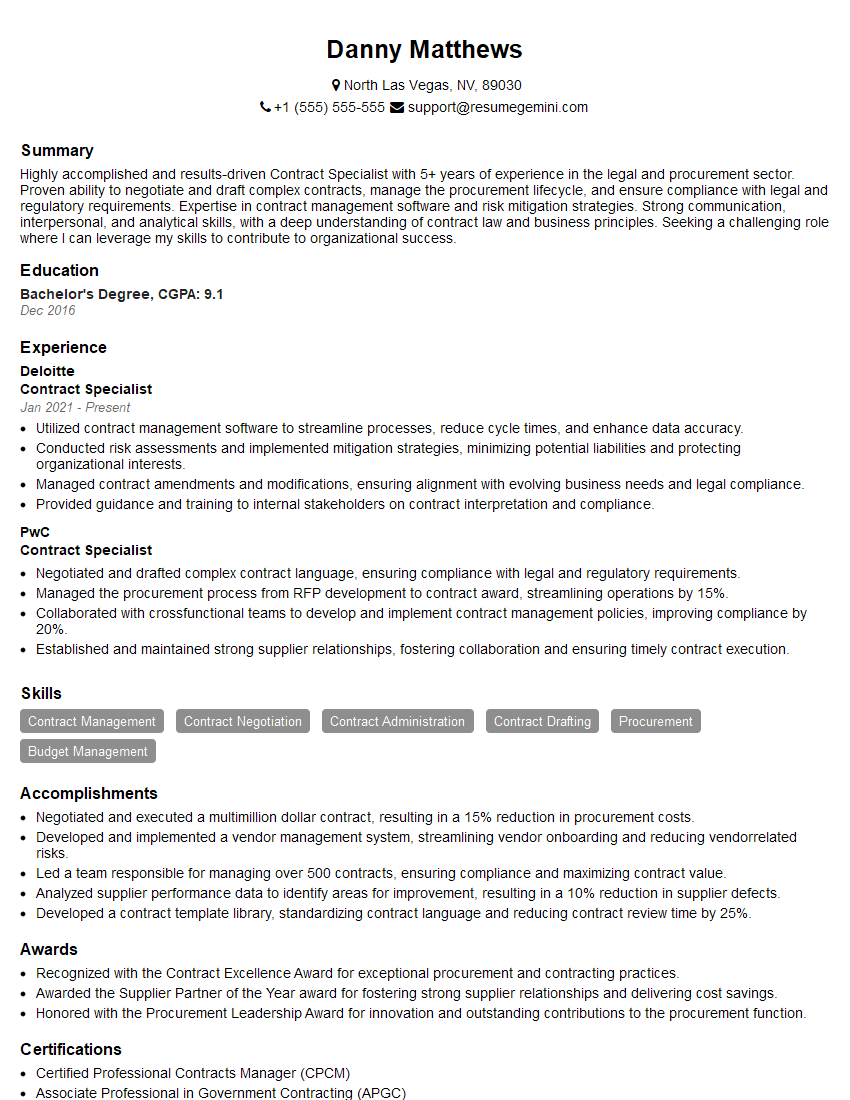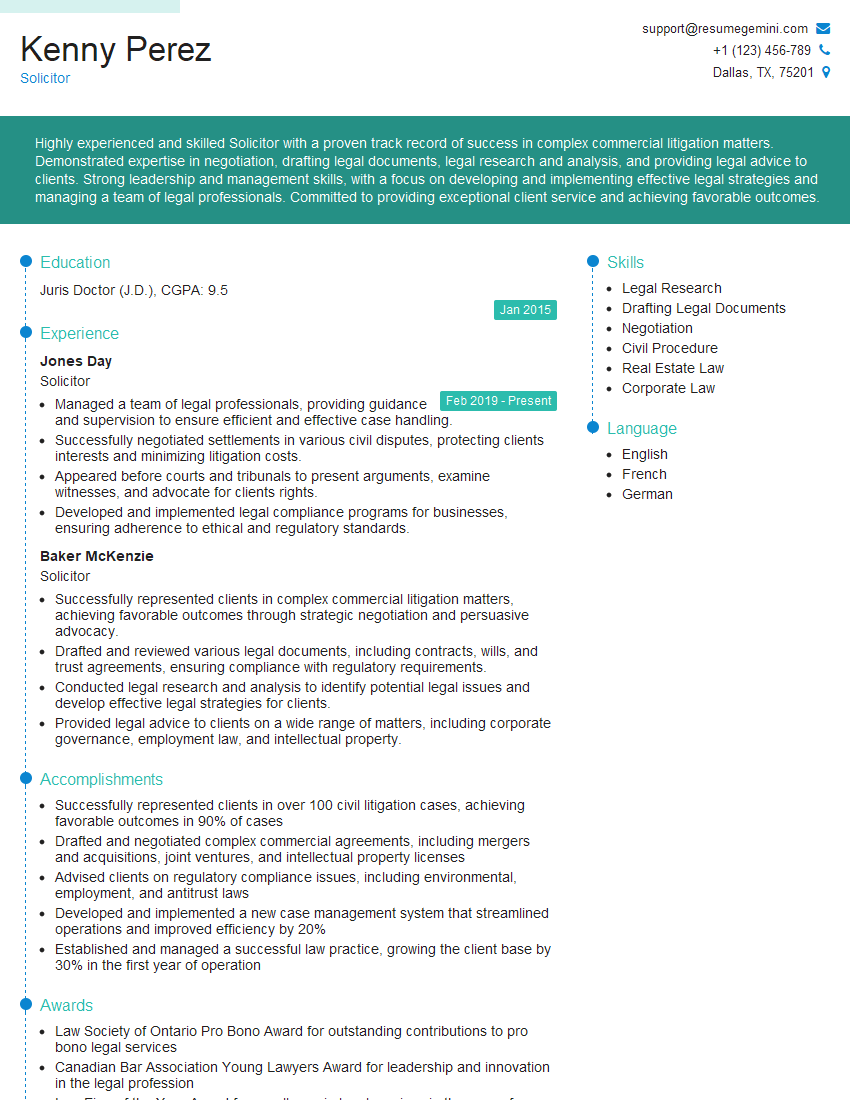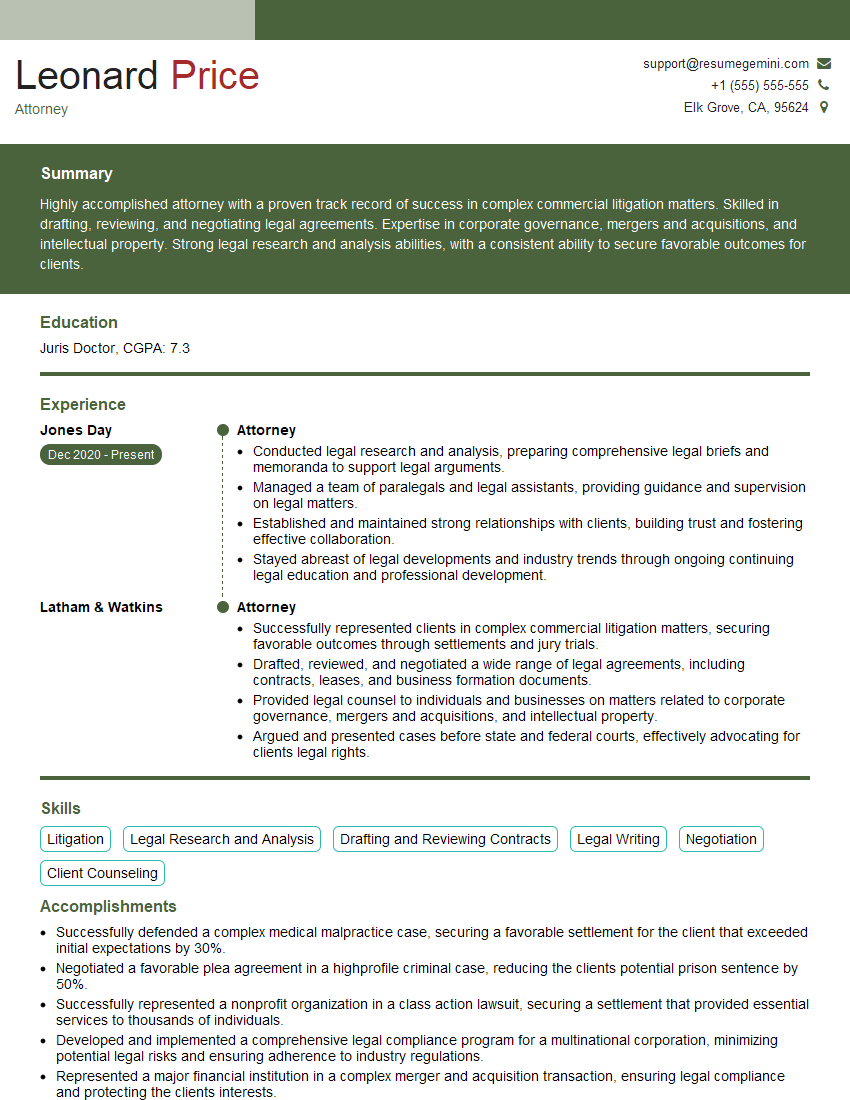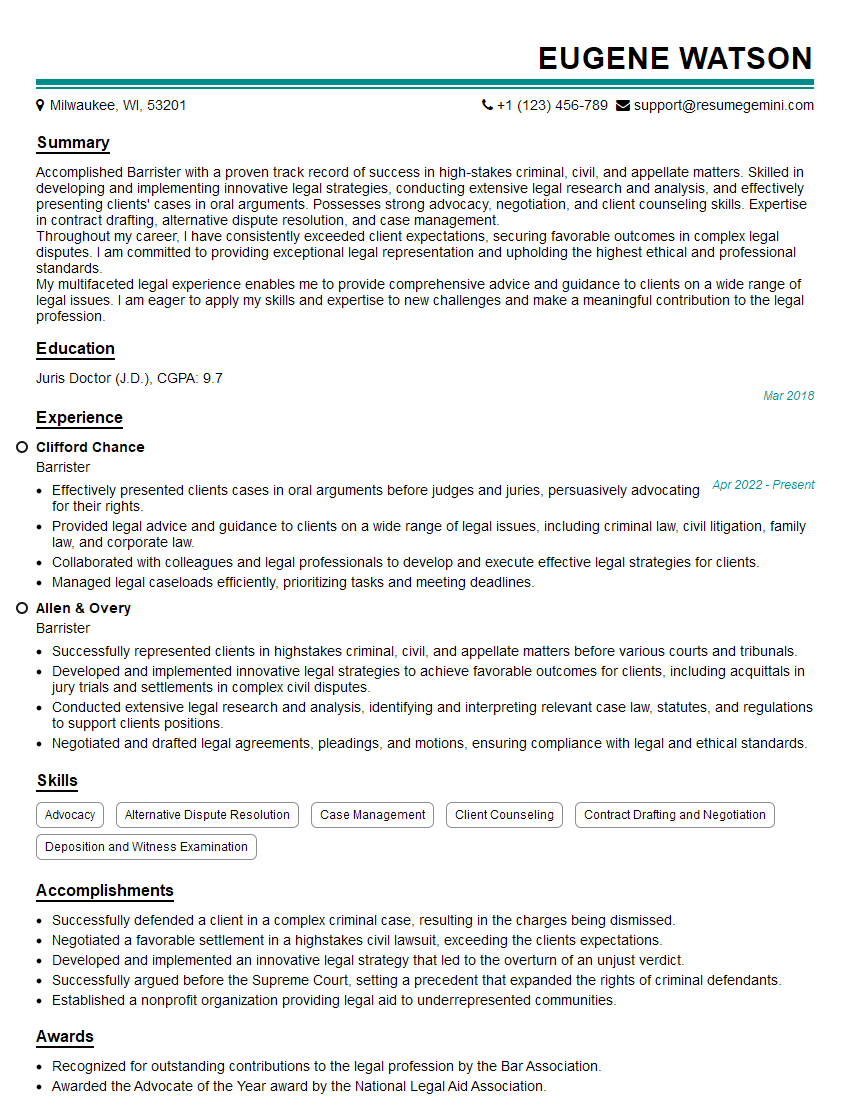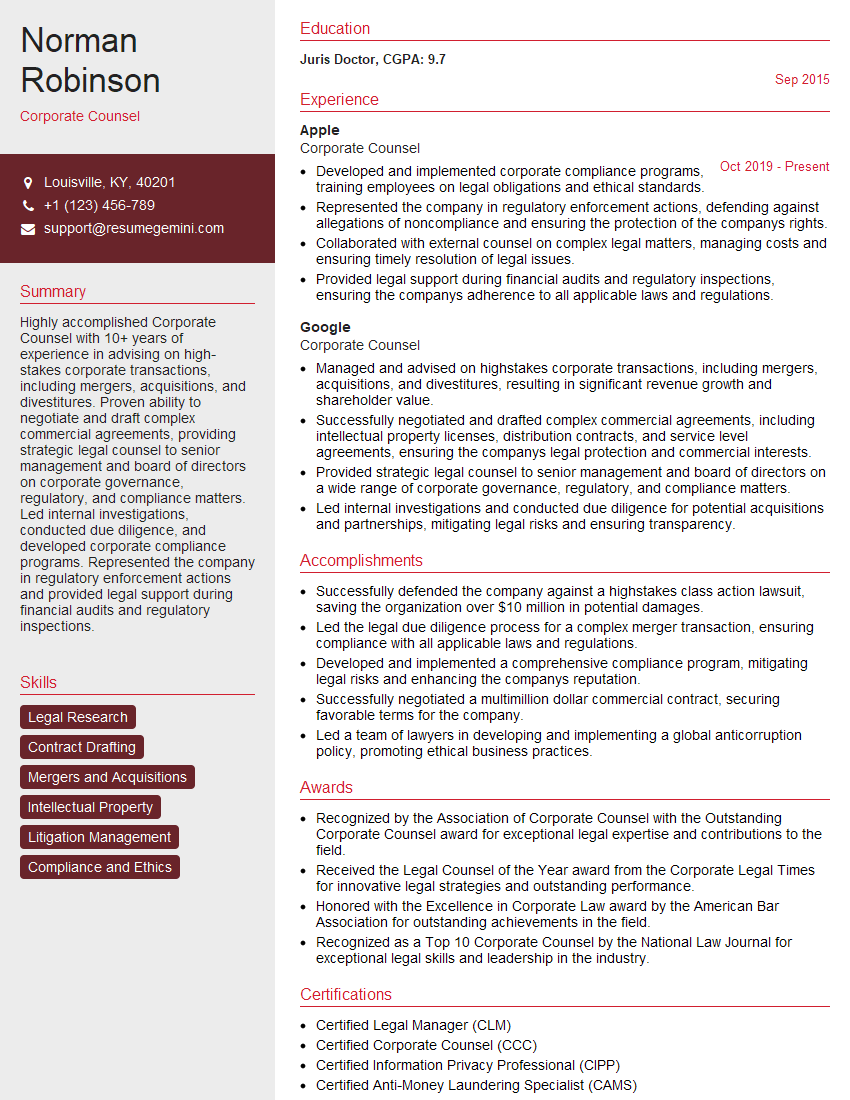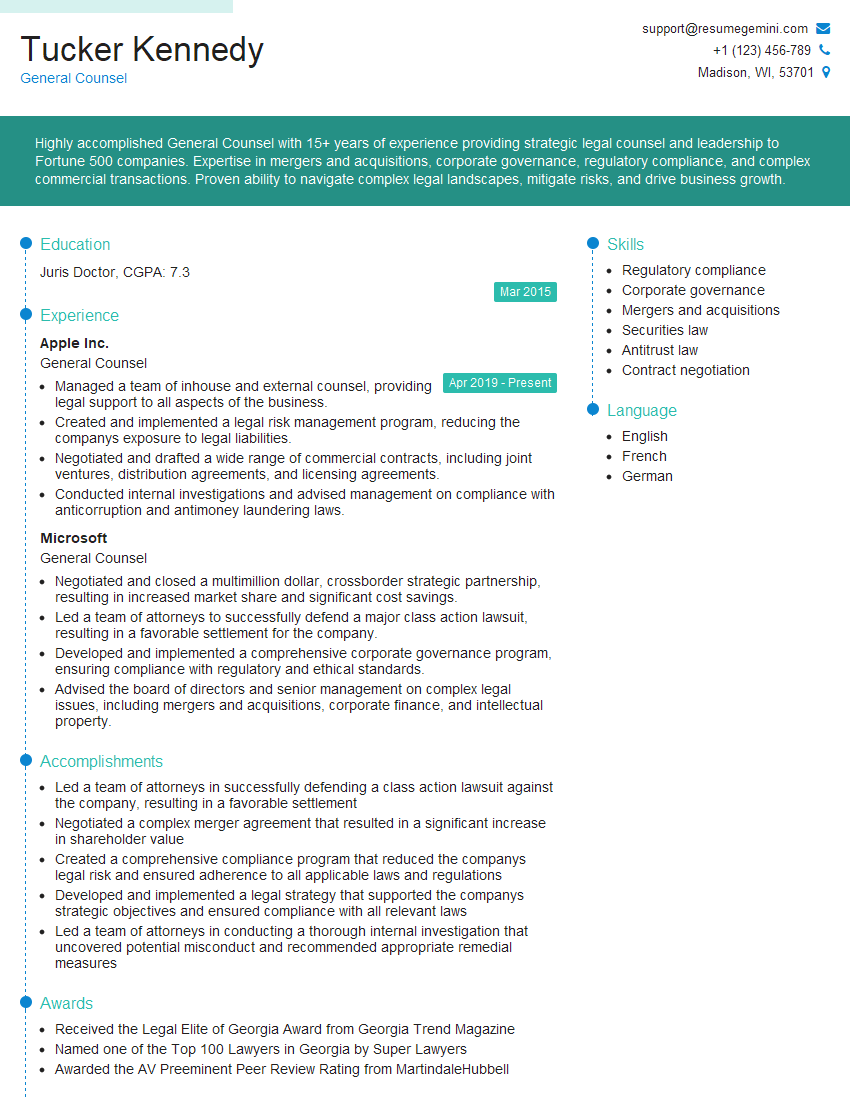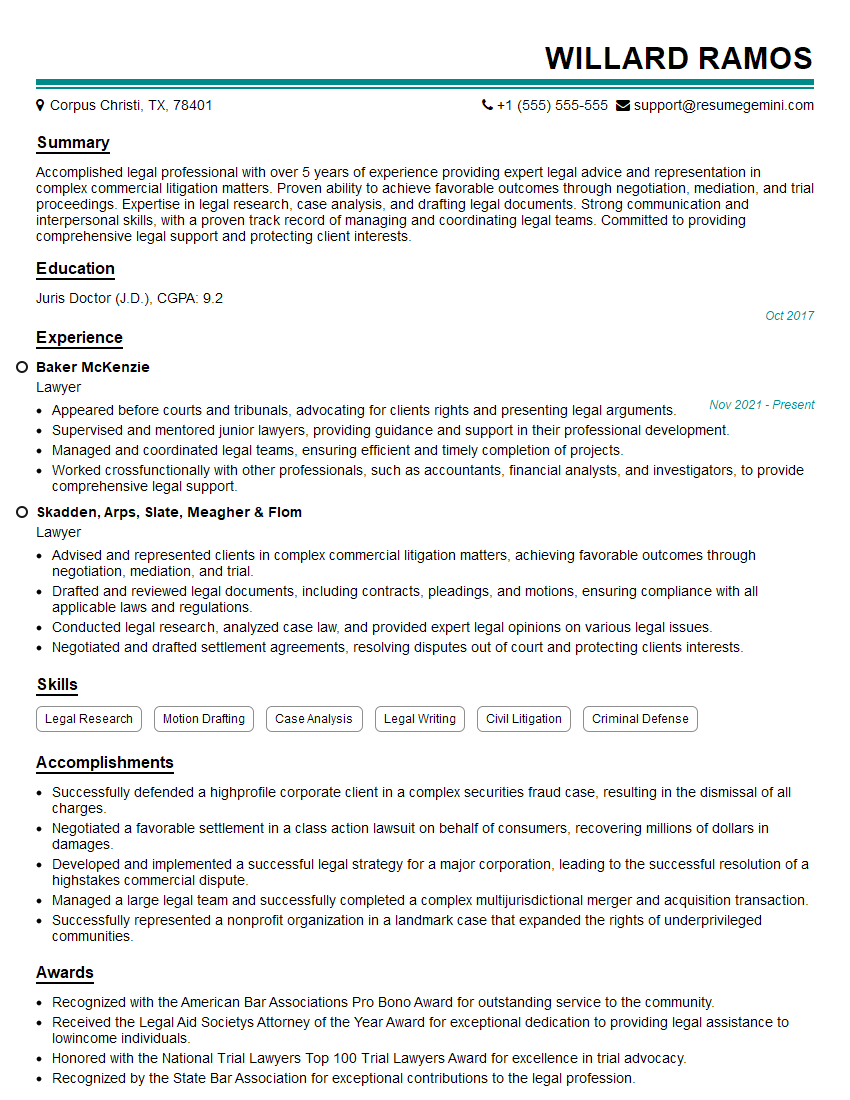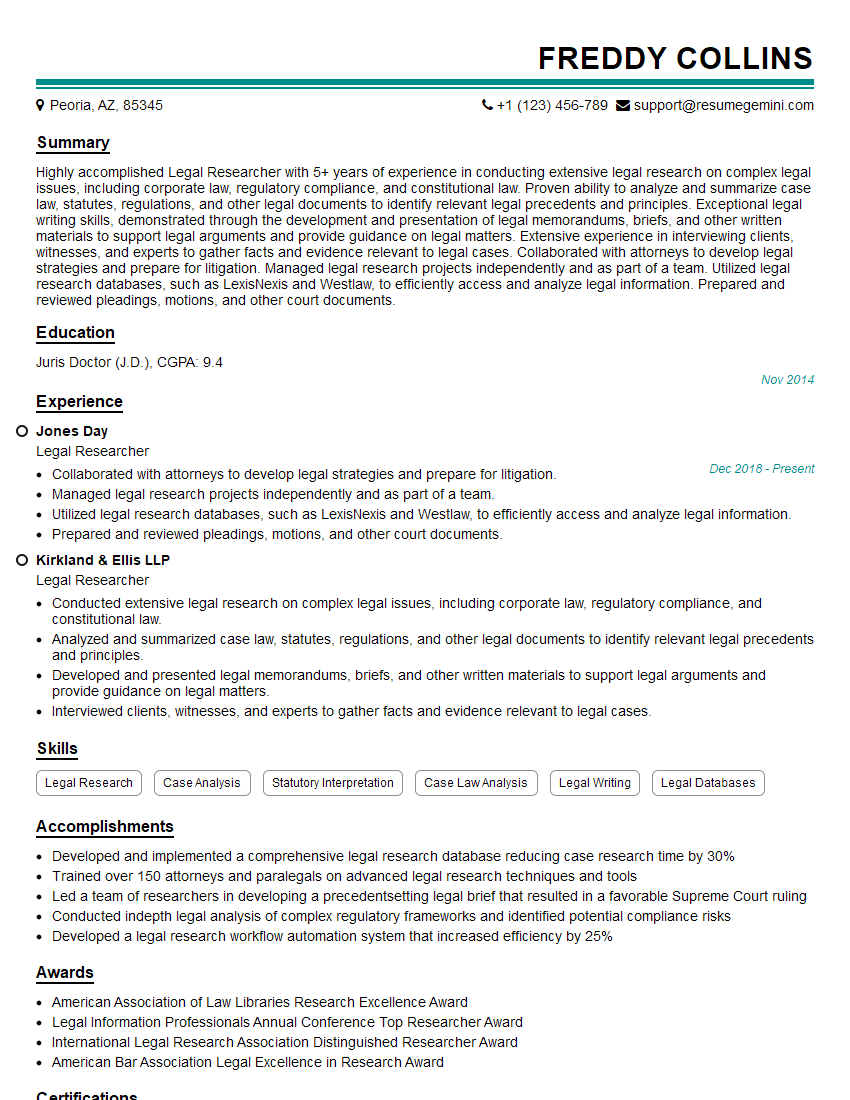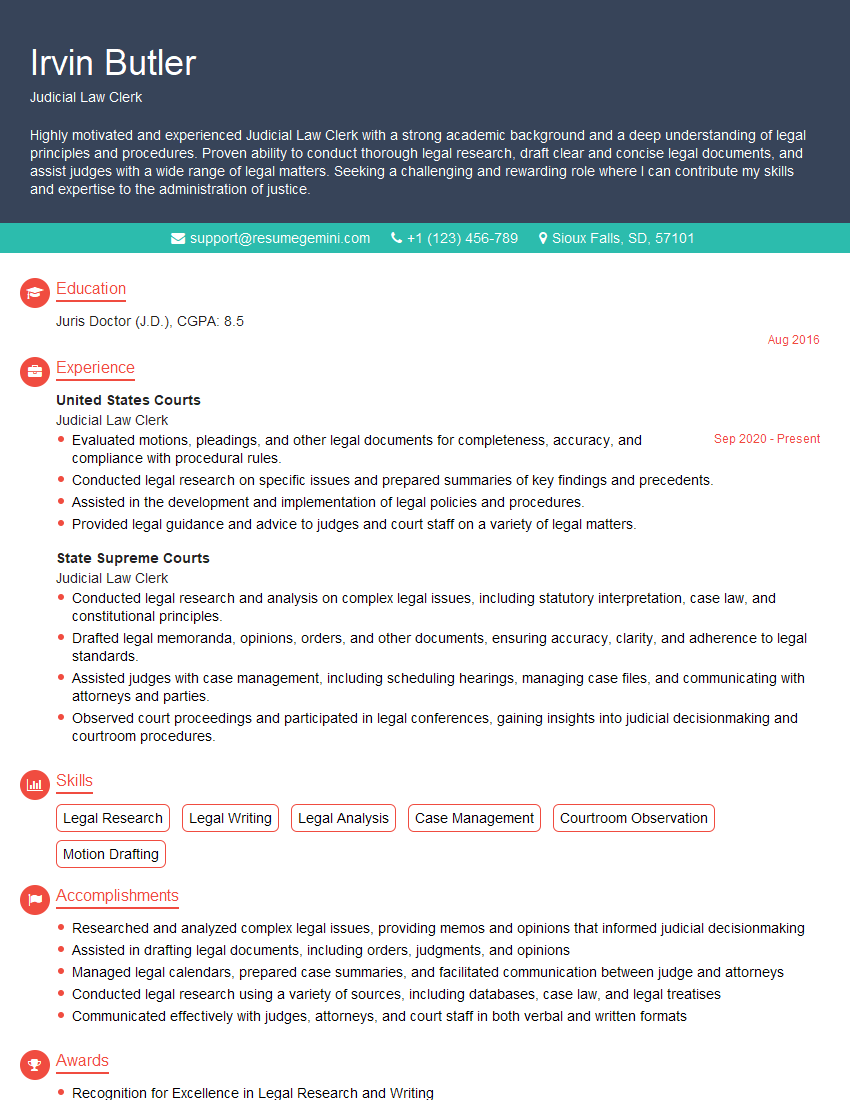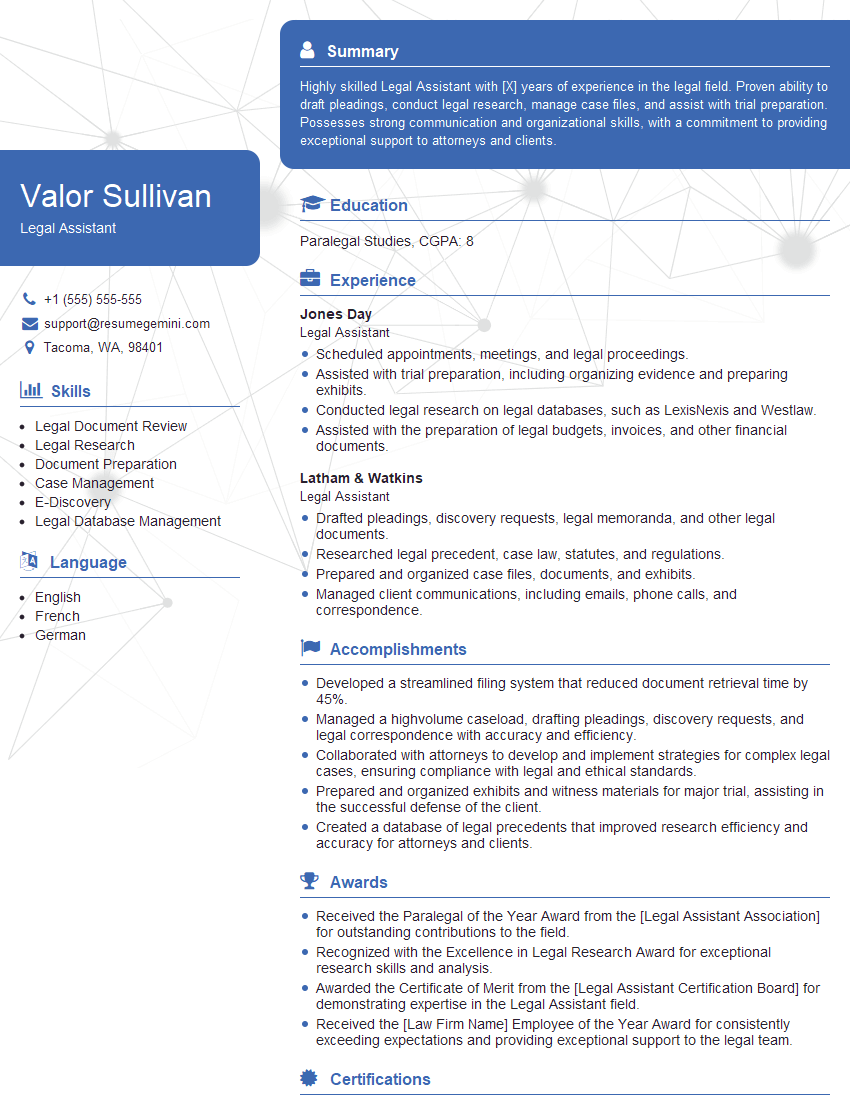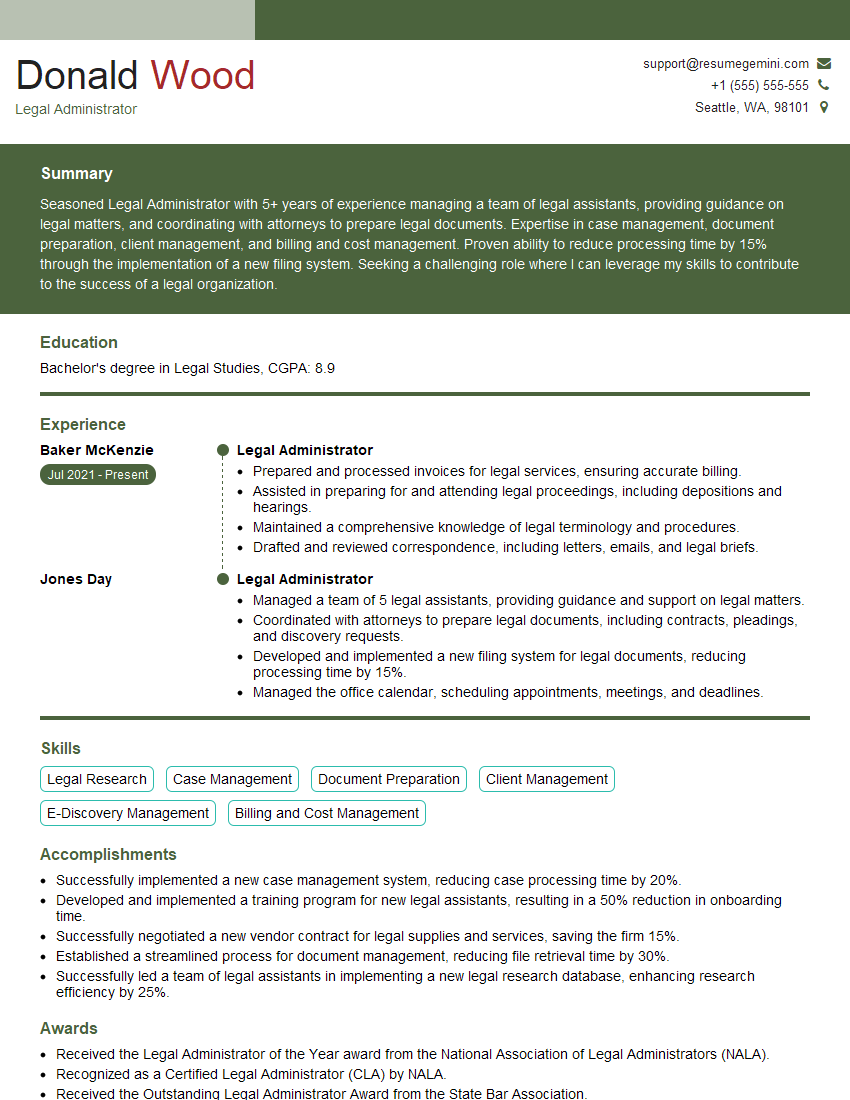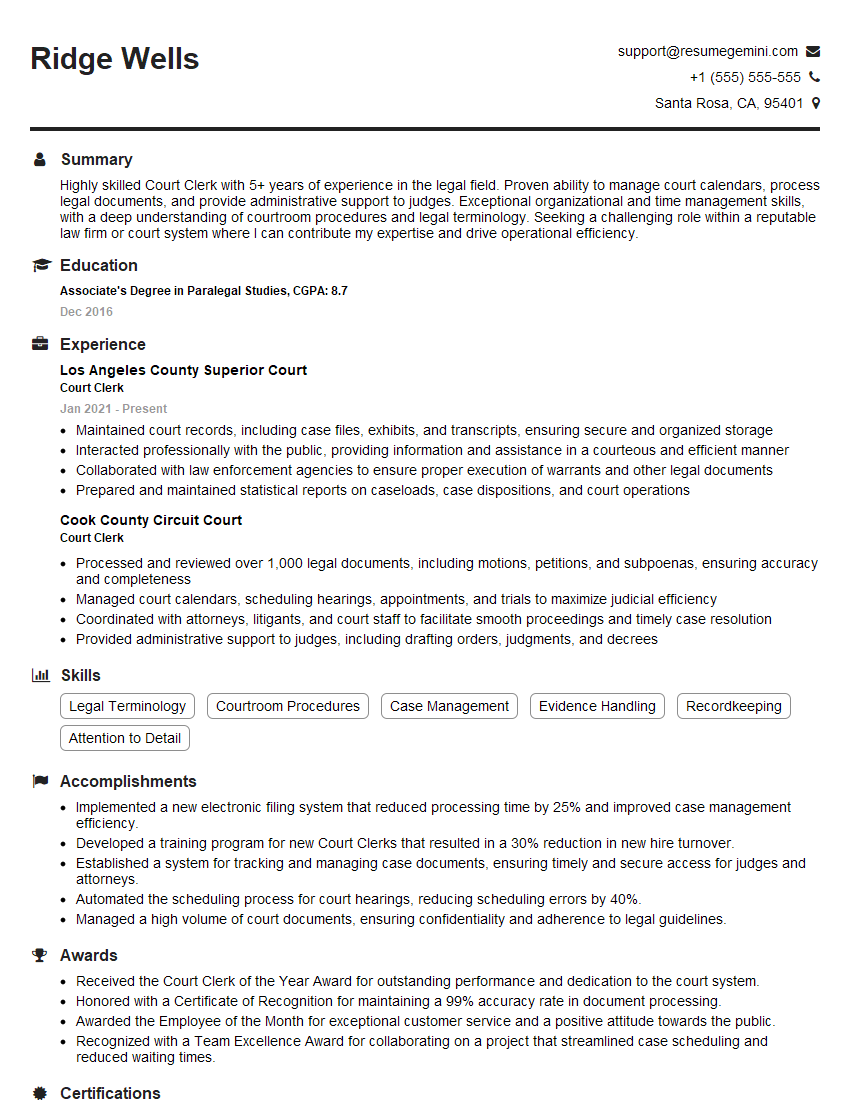Preparation is the key to success in any interview. In this post, we’ll explore crucial Collaborating Effectively with Judicial Officers and Legal Professionals interview questions and equip you with strategies to craft impactful answers. Whether you’re a beginner or a pro, these tips will elevate your preparation.
Questions Asked in Collaborating Effectively with Judicial Officers and Legal Professionals Interview
Q 1. Describe your experience working with judicial officers in a formal setting.
My experience working with judicial officers in formal settings spans over 15 years, encompassing various roles within the legal field. I’ve consistently prioritized building strong, respectful relationships based on clear communication and mutual understanding. This involves adhering strictly to courtroom etiquette, preparing meticulously for all meetings and hearings, and always demonstrating professionalism and respect for their authority and expertise. For instance, in one case involving a complex land dispute, my meticulous preparation, including detailed briefing documents and clear visual aids, greatly aided the judge in understanding the intricacies of the case, leading to a more efficient and effective hearing.
I’ve worked with judges at all levels, from local magistrates to Supreme Court justices, each with their unique styles and preferences. My approach has always been adaptable, focusing on tailoring my communication to effectively engage each judge. This involves not only understanding the specific legal context but also paying close attention to their individual communication styles – some prefer concise briefs, others appreciate a more detailed analysis. Successful collaboration necessitates recognizing these differences and adjusting accordingly.
Q 2. Explain your process for ensuring effective communication with legal professionals.
Effective communication with legal professionals hinges on clarity, precision, and proactive engagement. My process starts with clear and concise briefing documents, delivered in a timely manner. I prioritize using plain language, avoiding legal jargon whenever possible, and ensuring the information is easily digestible. I always confirm understanding, either through verbal confirmation or by seeking written acknowledgment. Regular updates are crucial, keeping all parties informed of progress and any potential roadblocks.
Beyond written communication, I actively cultivate open dialogue. Regular meetings, whether formal or informal, provide opportunities for questions, clarification, and collaboration. I believe in fostering a collaborative environment where all parties feel comfortable voicing their opinions and concerns. A simple but effective strategy is to actively listen, showing genuine interest in their perspectives. This approach builds trust and encourages open communication, which is paramount for collaborative success.
Q 3. How do you handle disagreements or conflicting opinions with legal professionals?
Disagreements are inevitable in the legal profession. My approach centers on respectful dialogue and collaborative problem-solving. When faced with conflicting opinions, I begin by actively listening to understand all perspectives. I encourage each party to clearly articulate their positions, supporting them with evidence and legal precedent. Then, I facilitate a discussion aimed at identifying common ground and exploring mutually acceptable solutions. This often involves brainstorming alternative approaches and seeking compromises that meet the core interests of all involved parties.
If a consensus cannot be reached through discussion, I may suggest alternative dispute resolution methods such as mediation or arbitration. It’s critical to maintain a neutral stance and facilitate a constructive conversation, even when dealing with highly charged emotions. Ultimately, the goal is to find a resolution that respects the legal principles and the rights of all parties involved.
Q 4. Have you ever had to adapt your communication style to meet the needs of a specific judicial officer or attorney? Describe the situation and your approach.
In one case, I worked with a senior partner known for her direct, no-nonsense communication style. She preferred concise emails and prioritized results over lengthy explanations. Initially, my detailed reports and elaborate explanations were met with impatience. I quickly adjusted my communication style, focusing on delivering clear, concise updates, highlighting key findings and action items. I replaced extensive narratives with bullet points and data-driven summaries.
This adaptation was crucial. By adjusting my communication style to match her preferences, I built a strong working relationship, ensuring that my contributions were effectively understood and valued. The shift in approach improved efficiency and enhanced the overall collaborative experience. It emphasizes the importance of understanding individual communication styles and tailoring your approach for effective interaction in diverse professional settings.
Q 5. How do you prioritize tasks when dealing with multiple demands from judges and lawyers?
Prioritizing tasks when dealing with multiple demands from judges and lawyers requires a structured and organized approach. I utilize a project management system that allows me to track deadlines, assign priorities, and monitor progress. This system takes into account the urgency and importance of each task, considering factors like court deadlines, client needs, and the potential impact on the overall case strategy.
I also employ time-blocking techniques, allocating specific time slots for particular tasks. This helps me maintain focus and avoid multitasking, which can often lead to reduced efficiency and errors. Open and honest communication with all parties is essential; I proactively inform them of my workload and potential delays, ensuring transparency and managing expectations effectively. Clear communication helps maintain trust and prevents misunderstandings that can arise from conflicting priorities.
Q 6. Explain a time you successfully negotiated a compromise between opposing legal parties.
In a contentious divorce case, the parties were locked in a bitter dispute over child custody arrangements. Both sides had strongly entrenched positions, making negotiation challenging. I employed a collaborative approach, starting by understanding each party’s underlying needs and concerns. I facilitated a series of meetings, focusing on open communication and active listening. I reframed the conflict from a zero-sum game to a search for solutions that met the best interests of the child.
Ultimately, we reached a compromise involving a flexible custody arrangement that addressed both parents’ concerns. This included a detailed parenting plan, carefully outlining visitation schedules, communication protocols, and decision-making processes. This successful negotiation relied on building trust, understanding underlying motivations, and finding common ground, leading to a mutually agreeable outcome that avoided a protracted and costly legal battle.
Q 7. How do you maintain confidentiality and professional ethics when collaborating with legal professionals?
Maintaining confidentiality and professional ethics is paramount in my work. I adhere strictly to all applicable rules of professional conduct and client confidentiality regulations. This includes avoiding discussions of case details in public spaces, securely storing client information, and only sharing information with authorized individuals. I am meticulous in protecting sensitive information and always seek explicit consent before disclosing client data.
Furthermore, I consistently maintain a professional distance, avoiding conflicts of interest and prioritizing objectivity in my actions and interactions. I recognize that breaches of confidentiality can have severe consequences, both professionally and legally. My commitment to ethical practice is unwavering, ensuring that client trust and the integrity of the legal process are consistently upheld.
Q 8. Describe your experience managing sensitive information shared by judicial officers.
Managing sensitive information from judicial officers requires meticulous adherence to confidentiality protocols and legal mandates. This involves understanding and strictly following rules around data protection, including those concerning client confidentiality and privileged information. My experience includes implementing robust security measures, such as encrypted storage and access controls, to safeguard sensitive data. I also meticulously document all information handling procedures, ensuring a clear audit trail. For instance, in a recent case involving sensitive financial records, I employed end-to-end encryption for all electronic transmissions and maintained a detailed log of all accesses to these files. This approach ensures compliance with legal and ethical obligations while maintaining the integrity of the information.
Q 9. How do you ensure all parties are informed and updated on the progress of legal matters?
Keeping all parties informed is crucial for transparency and efficient case management. My approach is multifaceted. I utilize a combination of regular email updates, secure online portals with access controls, and scheduled conference calls. This ensures timely dissemination of information tailored to each stakeholder’s needs. For instance, I might send summary reports to clients, detailed legal updates to attorneys, and procedural updates to court personnel. In addition, I employ a centralized case management system to track all communications, ensuring no information is overlooked. This proactive approach minimizes misunderstandings and promotes collaborative problem-solving. Imagine, for example, using a project management software to track deadlines, assign tasks and maintain a log of communications.
Q 10. How do you handle difficult personalities or challenging interactions in a legal environment?
Handling difficult personalities requires diplomacy, empathy, and a firm understanding of professional boundaries. I approach such situations with active listening, aiming to understand the root cause of any conflict. I focus on de-escalation techniques, such as using calm and neutral language, and reframing negative statements into constructive dialogue. Clear communication is vital. For instance, setting clear expectations at the outset of any interaction can minimize misunderstandings. In situations where conflict persists, I am not afraid to seek mediation or consult with senior colleagues or supervisors to find amicable resolutions, all while maintaining professional decorum and respect.
Q 11. Describe your understanding of legal etiquette and courtroom decorum.
Legal etiquette and courtroom decorum are paramount. My understanding encompasses appropriate attire, respectful language, adherence to court rules and procedures, and punctual attendance. This includes understanding the specific rules of each court I work with. I am familiar with the appropriate protocols for addressing judicial officers, attorneys, and other court personnel. For instance, I always address judges as “Your Honor” and attorneys as “Mr./Ms./Mx. [Last Name].” This careful attention to detail helps foster a professional and respectful atmosphere, essential for productive collaboration and successful outcomes.
Q 12. How do you proactively identify potential problems that might arise from collaboration with legal professionals?
Proactive problem identification is achieved through diligent planning, open communication, and thorough risk assessment. I anticipate potential issues by carefully reviewing case files, identifying potential conflicts of interest, and understanding each party’s expectations and goals. Regular check-ins with all stakeholders and close monitoring of deadlines are crucial. For example, I might proactively identify a potential scheduling conflict early in a case, suggesting alternative solutions before it becomes a significant problem. This systematic approach helps prevent delays, misunderstandings, and disputes, ensuring smoother collaboration and positive outcomes.
Q 13. Explain a time you had to deal with a demanding or difficult legal professional.
In one case, I worked with an attorney known for being demanding and impatient. I addressed this by maintaining clear and concise communication, meticulously documenting all interactions, and proactively addressing their concerns. When unexpected delays occurred, I explained the reasons transparently, offering alternative solutions. By demonstrating professionalism, competence, and a proactive approach, I was able to build a working relationship, and the case was successfully resolved. The key was to remain calm, patient, and focused on finding solutions, rather than engaging in conflict.
Q 14. How familiar are you with various legal software and tools used for collaboration?
I am proficient in various legal software and tools designed to facilitate collaboration. This includes case management systems such as CaseText and Westlaw, secure communication platforms like CourtClerk, and document management systems such as NetDocuments. My skills encompass using these tools to manage documents, track deadlines, schedule meetings, and share information securely with all stakeholders. I understand the importance of data security and compliance within these systems, ensuring all information handling aligns with legal and ethical requirements. Furthermore, I’m adaptable and quickly learn new software as needed, keeping abreast of the latest technological advancements in legal collaboration.
Q 15. How do you ensure the accuracy of legal documents and communications?
Ensuring the accuracy of legal documents and communications is paramount. It’s not just about avoiding errors; it’s about upholding the integrity of the legal process and protecting my clients’ interests. My approach is multifaceted and includes rigorous proofreading, utilizing technology for quality checks, and establishing clear communication protocols.
Multiple Proofreads: I always conduct multiple proofreads of any legal document, often with a fresh pair of eyes reviewing after the initial draft. This helps catch errors that might be missed during the first pass. I also employ a checklist to ensure all necessary elements are included and correctly formatted.
Technology-Assisted Checks: I leverage grammar and style checkers, as well as document comparison tools to identify any discrepancies between versions. For complex documents, specialized software can highlight potential inconsistencies or ambiguities.
Clear Communication Protocols: Before drafting a document, I ensure a clear understanding of the client’s needs and instructions. I frequently clarify any ambiguities to prevent misunderstandings that could lead to inaccuracies. Furthermore, I actively solicit feedback from colleagues before finalizing any important document.
For example, recently I was preparing a complex contract. By using a comparison tool, I discovered a crucial clause that had been inadvertently omitted from a revised version. This potentially significant oversight was caught thanks to my multi-layered quality control process.
Career Expert Tips:
- Ace those interviews! Prepare effectively by reviewing the Top 50 Most Common Interview Questions on ResumeGemini.
- Navigate your job search with confidence! Explore a wide range of Career Tips on ResumeGemini. Learn about common challenges and recommendations to overcome them.
- Craft the perfect resume! Master the Art of Resume Writing with ResumeGemini’s guide. Showcase your unique qualifications and achievements effectively.
- Don’t miss out on holiday savings! Build your dream resume with ResumeGemini’s ATS optimized templates.
Q 16. Explain your approach to managing deadlines and maintaining a productive workflow in a legal setting.
Managing deadlines and maintaining a productive workflow in a legal setting requires meticulous planning, prioritization, and effective time management. I use a combination of strategies to ensure timely completion of tasks while maintaining a high level of quality.
Project Planning: I break down large projects into smaller, manageable tasks with clearly defined deadlines. This allows for better tracking of progress and identification of potential bottlenecks early on.
Prioritization: Using methods like the Eisenhower Matrix (urgent/important), I prioritize tasks based on their importance and urgency, focusing on the most critical items first.
Time Blocking: I allocate specific time blocks for different tasks in my schedule, minimizing distractions and maximizing focus. This disciplined approach allows me to stay on track and meet deadlines consistently.
Regular Review: I regularly review my schedule and adjust it as needed to accommodate unexpected changes or delays. This proactive approach prevents last-minute rushes and ensures a smooth workflow.
For instance, in a recent case, I used a project management tool to track progress on multiple aspects of the case, allowing me to identify a potential delay in expert witness testimony and proactively address the issue, preventing it from impacting the overall case timeline.
Q 17. How do you handle pressure and tight deadlines in collaborative legal projects?
Handling pressure and tight deadlines in collaborative legal projects necessitates a calm, organized approach, excellent communication, and the ability to prioritize effectively. My strategy focuses on proactive planning, clear communication, and seeking support when needed.
Proactive Planning: Anticipating potential challenges and proactively addressing them minimizes stress and delays. This includes identifying potential bottlenecks and developing contingency plans.
Clear Communication: Open and honest communication with team members about potential delays or challenges is crucial. This fosters understanding and allows for collaborative solutions.
Prioritization and Delegation: Focusing on the most critical tasks and delegating less urgent tasks to others optimizes efficiency and reduces workload.
Stress Management Techniques: Implementing stress-reduction techniques like regular breaks and mindfulness exercises helps maintain focus and prevent burnout.
In one particularly challenging case, we were facing an extremely tight deadline for filing a critical motion. By working collaboratively, openly communicating challenges, and delegating tasks efficiently, we successfully met the deadline without compromising the quality of our work. We even celebrated a small team victory afterward to boost morale.
Q 18. How do you build and maintain effective working relationships with judicial officers and legal professionals?
Building and maintaining effective working relationships with judicial officers and legal professionals relies on professionalism, respect, clear communication, and a commitment to ethical conduct.
Professionalism: Always maintain a professional demeanor, demonstrating courtesy and respect in all interactions. This includes timely responses to communications and adherence to court protocols.
Clear Communication: Ensure clear and concise communication, both orally and in writing. Avoid jargon and use plain language to ensure understanding. Prepare thoroughly before any meeting or court appearance.
Respectful Collaboration: Approach interactions with a collaborative spirit, acknowledging the expertise of others. Engage respectfully in discussions, even when disagreeing.
Networking and Relationship Building: Actively participate in professional events and engage in respectful networking to build relationships and expand professional contacts.
For example, building a strong rapport with a particular judge involves understanding their preferences in terms of briefing style and courtroom procedure. By tailoring my approach, I have found that I can foster a more constructive and efficient working relationship.
Q 19. How would you describe your ability to actively listen and understand complex legal arguments?
Active listening and understanding complex legal arguments are fundamental to my practice. It’s more than just hearing words; it’s about truly grasping the nuances of the argument, identifying the key issues, and understanding the underlying rationale. My approach involves a combination of techniques:
Focused Attention: I give my full attention to the speaker, minimizing distractions and focusing on understanding their message. I maintain eye contact and avoid interrupting unnecessarily.
Clarifying Questions: I ask clarifying questions to ensure I understand the argument fully. This helps identify any ambiguities or areas where further explanation is needed.
Summarizing and Paraphrasing: I regularly summarize or paraphrase the speaker’s points to confirm my understanding and ensure accuracy. This also demonstrates my engagement and attentiveness.
Note-Taking: I take detailed notes to capture key arguments, supporting evidence, and relevant case law. This helps me synthesize information and analyze the arguments effectively.
In a recent case, my ability to actively listen and identify a subtle inconsistency in the opposing counsel’s argument was instrumental in crafting a successful counter-argument and ultimately contributing to a favorable outcome for my client.
Q 20. How do you contribute to a positive and collaborative team environment in a legal setting?
Contributing to a positive and collaborative team environment requires a proactive approach, focusing on open communication, mutual respect, and a shared commitment to success. My contributions include:
Open Communication: I foster open and honest communication among team members, encouraging the sharing of ideas and perspectives. I actively seek feedback and provide constructive criticism.
Mutual Respect: I treat all team members with respect and value their contributions, regardless of their seniority or role. I actively listen to their concerns and address them appropriately.
Collaboration and Teamwork: I actively participate in collaborative efforts, sharing my expertise and knowledge to support the team’s goals. I am willing to assist colleagues when needed and readily offer help.
Positive Attitude: I maintain a positive and supportive attitude, encouraging team members and fostering a sense of camaraderie.
In past team projects, I have often been instrumental in resolving conflicts by facilitating open communication and encouraging team members to find common ground. A positive team environment leads to better outcomes and a more enjoyable work experience for everyone involved.
Q 21. How do you utilize technology to enhance collaboration with legal professionals?
Technology plays a crucial role in enhancing collaboration with legal professionals. I utilize a range of tools to improve communication, document sharing, and project management.
Cloud-Based Document Sharing: Platforms like Dropbox, Google Drive, or SharePoint allow for secure and efficient sharing of documents with clients and colleagues, regardless of location. Version control features prevent confusion and ensure everyone is working with the most up-to-date version.
Video Conferencing: Tools like Zoom or Microsoft Teams enable real-time communication with clients and colleagues, facilitating quick discussions and efficient problem-solving, especially helpful when dealing with geographically dispersed teams.
Project Management Software: Asana, Trello, or Monday.com help in organizing tasks, assigning deadlines, and tracking progress on complex projects. This provides transparency and facilitates effective collaboration within the team.
Legal Research Databases: Westlaw, LexisNexis, and other legal research databases provide access to extensive legal information, streamlining the research process and ensuring access to the most current case law and statutes.
For example, during a recent trial, we utilized video conferencing to connect with an expert witness located in another state, saving time and resources. The use of a cloud-based document sharing system ensured that all team members had access to the latest court filings and witness statements.
Q 22. How do you approach resolving conflicts that arise during legal proceedings?
Resolving conflicts during legal proceedings requires a structured approach emphasizing communication and understanding. My strategy involves active listening to all parties involved to identify the root causes of the conflict. I then facilitate open dialogue, encouraging each party to express their perspectives and concerns without interruption. This often involves rephrasing statements to ensure mutual understanding and clarifying misunderstandings. If a compromise seems unlikely, I explore alternative dispute resolution methods, such as mediation or arbitration, to guide the parties towards a mutually agreeable solution. It’s crucial to maintain a neutral stance and focus on finding a solution that respects the rights and interests of all involved.
For example, in a case involving a disagreement over witness testimony, I facilitated a meeting where each side explained their interpretation of the evidence. By highlighting the areas of agreement and addressing the points of contention calmly, we were able to reach a compromise that satisfied both parties and avoided unnecessary delays in the proceedings.
Q 23. How familiar are you with different court procedures and rules of evidence?
My familiarity with court procedures and rules of evidence is extensive. I’ve worked across various jurisdictions and court levels, gaining hands-on experience with a wide range of cases, from civil litigation to criminal prosecutions. I have a thorough understanding of rules regarding admissibility of evidence, witness examination, and legal precedents. I am proficient in identifying and addressing potential evidentiary issues proactively. My knowledge extends to understanding the specific rules and procedures governing different types of hearings and trials, enabling me to anticipate and address potential procedural challenges effectively.
This knowledge allows me to anticipate potential issues and ensure compliance with all relevant rules and regulations. I can easily navigate the complexities of different court systems and confidently prepare necessary documentation to ensure a smooth and efficient legal process.
Q 24. How would you handle a situation where a judicial officer or lawyer provided conflicting instructions?
Receiving conflicting instructions from a judicial officer and a lawyer is a delicate situation requiring careful navigation. My first step would be to politely clarify the discrepancy, seeking to understand the basis for the conflicting instructions. I would carefully review the relevant documents and applicable laws to identify the source of the conflict. Once the nature of the discrepancy is clear, I would attempt to privately communicate with each party individually to gain a fuller understanding of their perspectives. The goal is to find a common ground that respects both sets of instructions, acknowledging that the judicial officer’s directives always have precedence. If a resolution cannot be found, I would seek guidance from a senior legal professional or escalate the matter according to established protocols.
Transparency and a proactive approach are crucial here. Documenting all communications and decisions taken is essential to maintain accountability and prevent future misunderstandings.
Q 25. Describe a time you had to present complex information in a clear and concise manner to a judicial officer.
In a recent case involving complex financial data, I needed to explain a series of intricate transactions to a judge. Instead of simply presenting raw data, I created a visually engaging presentation using charts and graphs that summarized the key financial movements. I explained the data in plain language, avoiding technical jargon, and focused on the overall narrative, showing how the transactions demonstrated the defendant’s actions. I also prepared a concise written summary to complement the presentation, ensuring that the judge had a clear and readily available reference point. The judge praised the clarity of my presentation and its effectiveness in conveying a complex financial narrative.
This experience underscored the importance of tailoring communication to the audience’s needs. It’s crucial to present information in a format that is easy to understand and avoids unnecessary complexity.
Q 26. How do you maintain objectivity and impartiality when working with legal professionals representing opposing sides?
Maintaining objectivity and impartiality when working with opposing legal professionals is paramount. I achieve this by consciously avoiding any expression of personal preference or bias. I treat all parties with equal respect and professionalism, focusing solely on the legal facts and evidence presented. I listen carefully to all perspectives, ensuring that each party has an equal opportunity to present their case. I strive to maintain a neutral emotional stance, setting aside any personal feelings or opinions about the parties involved. Strict adherence to the rules of evidence and procedure further reinforces my impartiality, ensuring that all arguments are evaluated based on their legal merit.
An example would be a case where I was managing evidence. I treated the evidence presented by both sides equally, ensuring that all information was properly handled, verified and stored regardless of which side provided it.
Q 27. How do you ensure that all parties understand their roles and responsibilities in a legal case?
Clearly defining roles and responsibilities is fundamental to a successful legal case. I start by holding an initial meeting with all parties involved, explaining the legal process in clear, non-technical terms. I provide each party with a written document outlining their specific roles and responsibilities, including deadlines for submitting information and expectations for participation. Throughout the proceedings, I regularly communicate with each party to ensure that they understand their obligations and to address any questions or concerns they may have. I actively facilitate communication between the parties, encouraging collaboration where appropriate while maintaining a structured approach to ensure the case progresses efficiently and fairly.
Using clear, concise language and visual aids can help ensure everyone understands. Regular check-ins are essential to keep everyone on track.
Q 28. How would you handle a situation involving ethical dilemmas or potential conflicts of interest?
Addressing ethical dilemmas or potential conflicts of interest requires immediate attention and a transparent approach. If I identify a potential conflict, I immediately disclose it to all relevant parties and to my supervisor. I then follow established ethical guidelines and procedures, prioritizing the integrity of the legal process. This may involve recusal from the case if my involvement could compromise impartiality or create a conflict of interest. Documenting all actions and decisions related to the ethical dilemma is essential to maintain transparency and accountability. Seeking advice from experienced colleagues or ethical committees can also be vital in navigating complex situations.
Maintaining high ethical standards is not optional; it’s the foundation of my professional practice. Transparency and proactive action are key to addressing these challenges.
Key Topics to Learn for Collaborating Effectively with Judicial Officers and Legal Professionals Interview
- Understanding the Judicial System: Grasping the roles and responsibilities of judges, court clerks, and other legal professionals within the judicial system. This includes understanding court procedures and protocols.
- Effective Communication Strategies: Mastering clear, concise, and respectful communication, both written and verbal, adapting your style to the audience and context. This includes active listening and non-verbal cues.
- Professionalism and Ethics: Demonstrating impeccable professionalism, maintaining confidentiality, and adhering to ethical standards in all interactions.
- Collaboration and Teamwork: Highlighting your ability to work effectively within a team, contributing constructively to collaborative efforts, and managing conflict professionally.
- Legal Research and Analysis: Demonstrating familiarity with legal research methods and the ability to synthesize complex information concisely and accurately.
- Problem-Solving and Decision-Making: Showcasing your ability to identify and analyze problems, develop solutions, and make sound judgments within the context of the legal environment.
- Conflict Resolution and Negotiation: Understanding techniques for resolving conflict and negotiating effectively, while maintaining respectful and professional interactions.
- Time Management and Organization: Demonstrating strong organizational skills and the ability to manage multiple tasks and deadlines effectively.
- Technological Proficiency: Highlighting your familiarity with relevant legal technologies and software used in modern legal settings.
- Practical Application: Preparing examples from your experience (past jobs, volunteer work, academic projects) that showcase these skills in action.
Next Steps
Mastering collaboration with judicial officers and legal professionals is crucial for career advancement in many legal fields. A strong understanding of these concepts significantly enhances your job prospects and demonstrates a commitment to professionalism and ethical conduct. To further enhance your candidacy, create an ATS-friendly resume that showcases these skills effectively. ResumeGemini is a trusted resource to help you build a professional and impactful resume. Examples of resumes tailored to highlight experience in collaborating effectively with judicial officers and legal professionals are available to further guide you.
Explore more articles
Users Rating of Our Blogs
Share Your Experience
We value your feedback! Please rate our content and share your thoughts (optional).
What Readers Say About Our Blog
Hi, I’m Jay, we have a few potential clients that are interested in your services, thought you might be a good fit. I’d love to talk about the details, when do you have time to talk?
Best,
Jay
Founder | CEO



